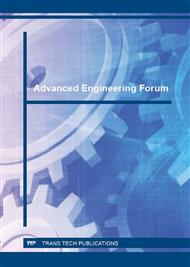[1]
G. Zhang, H. Hao, X. Wu, S. Hu, An experimental investigation of curved surface straight edge forming, J Manuf Process, 2 (2000) 241–246.
Google Scholar
[2]
H. Livatyali, S.J. Larris, Experimental investigation on forming defects in flat surface–convex edge hemming: roll, recoil and warp, J Mater Process Technol, 153–154 (2004) 913–919.
DOI: 10.1016/j.jmatprotec.2004.04.425
Google Scholar
[3]
H. Livatyali, A. Muderrisoglu, M.A. Ahmetoglu, N. Akgerman, G.L. Kinzel, T. Altan, Improvement of hem quality by optimizing flanging and pre-hemming operations using computer-aided die design, J Mater Process Technol, 98 (2000) 41–52.
DOI: 10.1016/s0924-0136(99)00304-0
Google Scholar
[4]
H. Livatyali, T. Laxhuber, T. Altan, Experimental investigation of forming defects in flat surface–convex edge hemming, J Mater Process Technol, 146 (2004) 20–27.
DOI: 10.1016/s0924-0136(03)00840-9
Google Scholar
[5]
H. Livatyali, T. Altan, Prediction and elimination of spring back in straight flanging using computer aided design methods. Part 1: experimental investigation, J Mater Process Technol, 117 (2001) 262–268.
DOI: 10.1016/s0924-0136(01)01164-5
Google Scholar
[6]
H. Livatyali, H.C. Wu, T. Altan, Prediction and elimination of spring back in straight flanging using computer aided design methods. Part 2: FEM predictions and tool design, J Mater Process Technol, 120 (2002) 348–354.
DOI: 10.1016/s0924-0136(01)01161-x
Google Scholar
[7]
H. Livatyali, G.L. Kinzel, T. Altan, Computer aided die design of straight flanging using approximate numerical analysis, J Mater Process Technol, 142 (2003) 532–543.
DOI: 10.1016/s0924-0136(03)00655-1
Google Scholar
[8]
A. Muderrisoglu, M. Murata, S. Tufekci, M. Ahmetoglu, G.L. Kinzel, T. Altan, Bending, flanging and hemming of sheet—an experimental study, J Mater Process Technol, 59 (1996) 10–17.
DOI: 10.1016/0924-0136(96)02281-9
Google Scholar
[9]
G. Lin, J. Li, H.S. Jack, W. Cai, A computational response surface study of three-dimensional aluminum hemming using solid-to-shell mapping, Trans ASME, 12 (2007) 360–368.
DOI: 10.1115/1.2515430
Google Scholar
[10]
G. Zhang, X. Wu, S. Hu, A study on fundamental mechanisms of warp and recoil in hemming, J Eng Mater Technol, 123 (2001) 436–441.
DOI: 10.1115/1.1396348
Google Scholar
[11]
N. Le Maoût, S. Thuillier, P.Y. Manach, Aluminum alloy damage evolution for different strain paths – Application to hemming process, Engineering Fracture Mechanics, 76 (2009) 1202–1214.
DOI: 10.1016/j.engfracmech.2009.01.018
Google Scholar
[12]
N. Le Maoût, S. Thuillier, P.Y. Manach, Classical and Roll-hemming Processes of Pre-strained Metallic Sheets, Experimental Mechanics, 50 (2010) 1087-1097.
DOI: 10.1007/s11340-009-9297-7
Google Scholar
[13]
N. Le Maoût, P.Y. Manach, S. Thuillier, Influence of prestrain on the numerical simulation of the roller hemming process, Journal of Materials Processing Technology, 212 (2012) 450–457.
DOI: 10.1016/j.jmatprotec.2011.10.008
Google Scholar
[14]
S. Thuillier, N. Le Maoût, P.Y. Manach, D. Debois, Numerical simulation of the roll hemming process, J Mater Process Technol, 198 (2008) 226–233.
DOI: 10.1016/j.jmatprotec.2007.07.004
Google Scholar
[15]
X. Hu, Z.Q. Lin, S.H. Li, Y.X. Zhao, Fracture limit prediction for roller hemming of aluminum alloy sheet, Materials and Design, 31 (2010) 1410–1416.
DOI: 10.1016/j.matdes.2009.08.039
Google Scholar
[16]
X. Hu, Y.X. Zhao, S. Huang, S.H. Li, Z.Q. Lin, Numerical analysis of the roller hemming process, Int J Adv Manuf Technol, 62 (2012) 543–550.
DOI: 10.1007/s00170-011-3822-4
Google Scholar
[17]
S. Gurgen, M.I. Gokler, H. Darendeliler, C.C. Celikkaya, K. Erden, Analysis of roller hemming process for a vehicle tailgate closure, AIP Conf Proc, 1532 (2013) 367–374.
DOI: 10.1063/1.4806848
Google Scholar
[18]
G. Lin, S.J. Hu, M. Koc, W. Cai, M.L. Wenner, A Computational Response Surface Study of Curved Surface Curved Edge Aluminum Hemming Using Solid to Shell Mapping, ASME Int Conf on Manuf Sci and Eng, 21031 (2006) 267-276.
DOI: 10.1115/msec2006-21031
Google Scholar
[19]
N. Le Maoût, S. Thuillier, P.Y. Manach, Drawing, Flanging and Hemming of Metallic Thin Sheets: A Multistep Process, Materials and Design, 31 (2010) 2725-2736.
DOI: 10.1016/j.matdes.2010.01.030
Google Scholar
[20]
G. Lin, M. Koc, S.J. Hu, W. Cai, Three Dimensional Numerical Simulations of Curved Edge Curved Surface Hemming of Aluminum Alloy, ASME Int Mech Eng Cong and Expo, 60705 (2004) 503-511.
DOI: 10.1115/imece2004-60705
Google Scholar
[21]
M. Dao, M. Li, A Micromechanics Study on Strain Localization Induced Fracture Initiation in Bending Using Crystal Plasticity Models, Philosophical Magazine, 81 (2001) 1997-(2020).
DOI: 10.1080/01418610108216649
Google Scholar
[22]
R. Schleich, M. Sindel, M. Liewald, Investigation on the Effect of Curvature on Forming Limit Prediction for Aluminum Sheet Alloys, International Journal of Material Forming, 2 (2008) 69-74.
DOI: 10.1007/s12289-009-0394-z
Google Scholar
[23]
R. Schleich, C. Held, M. Sindel, M. Liewald, Investigation on the Effect of Curvature and Sheet Thickness on Forming Limit Prediction for Aluminum Sheet Metal Alloys, International Journal of Material Forming, 2 (2009) 411-414.
DOI: 10.1007/s12289-009-0503-z
Google Scholar
[24]
R. Schleich, M. Liewald, Development of an Anisotropic Failure Criterion for Characterising the Influence of Curvature on Forming Limits of Aluminum Sheet Metal Alloys, International Journal of Material Forming, 3 (2010) 1175- 1178.
DOI: 10.1007/s12289-010-0982-y
Google Scholar


